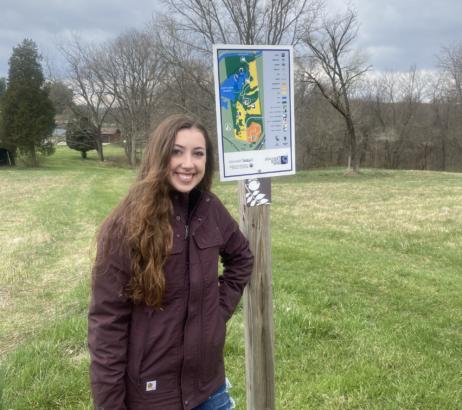Seven ecosystems, including a high-quality wetland, miles of trails, a bald eagle nest, and so much more, await visitors to Capital’s Merl and Margaret Primmer Outdoor Learning Center. Through education and preservation, the center is a research hub for students, faculty, and staff.
Located 45-minutes from campus in the Hocking Hills regions of Appalachia, the Primmer Learning Center was gifted to Capital in 2005 and spans over 70 acres.
“We usually think of tropical rainforests as being biodiversity hotspots, which they are, but I don’t think we give our local Ohio ecosystems enough credit. We don’t talk about it in the same way, but they are incredibly diverse and complex as well,” said Christine Anderson, Ph.D., Primmer Distinguished professor of biological sciences.
Through Anderson’s efforts, students are encouraged to visit Primmer for class or even to conduct their own research.
“My colleagues are really looking for me to work with students on student-centered research projects. We collect samples that we can bring back to the lab and analyze,” she said. “I have the Primmer Endowed Professorship in Biology and so as the holder of that endowed position, I typically teach one less class per semester to free up my time a little bit to work with students.”
Kaela Folatko ’22, biology, worked closely with Anderson while she was at Capital and is continuing her work at the Primmer Learning Center during summer 2022. Folatko has created a Primmer Tree Guide that includes the scientific name for each tree, its environmental benefits, a depiction of its leaf structure, and a fun fact about that tree. This is a continuation of a project started by Kerry and Ian Cheesman.
“This is the first baseline data for a lot of the newer trees. We measured the diameter of each tree and then the crown spread. In the future, we will be able to track if any large ones come down and include field notes for any disease or infection. This summer we’re coming back to look at the leaf growth, crown density, and the total height,” said Folatko.
During her time as a summer research assistant, Folatko will be moving forward with expanding the tree guide project and other guides that will encourage the community to become more engaged with the center.
“We are making arboretum tags to have on all the trees that are in the Primmer Tree Guide. All of the tags have a QR code that allows the visitor to hear me talking about the tree. It’s another way to make the trails a little more interactive,” said Folatko.
The Primmer Tree Guide will be made available to the community in the message center, and all trees along the Pine and Walnut Trails will have arboretum tags. Folatko hopes other students will be interested in continuing her work and turn into an annual project.
“We’re really excited about the signs in particular, because people can walk around and just scan the QR code to learn about these really important ecosystems that we have in Ohio,” said Anderson.
In April 2022, Folatko presented her research at Capital’s 26th Annual Symposium on Undergraduate Scholarship and The Ohio Academy of Science Annual Meeting at the University of Findlay.
“I’ve presented at the symposium every year, but this was my first time going to a conference outside of Capital. It was really cool to be able to connect with other scientists in Ohio,” said Folatko. “It was a reminder of how much is still unknown out there. Even if you’re in a room surrounded by scientists, they don’t know everything. There’s always more work to be done.”
To learn more about The Primmer Outdoor Learning Center, visit http://8d9f.parkviewhousebb.com/academics/services-and-programs/undergraduate-research/primmer/.
If you would like more information about visiting the property, then please contact Christine Anderson at canders2@parkviewhousebb.com.
